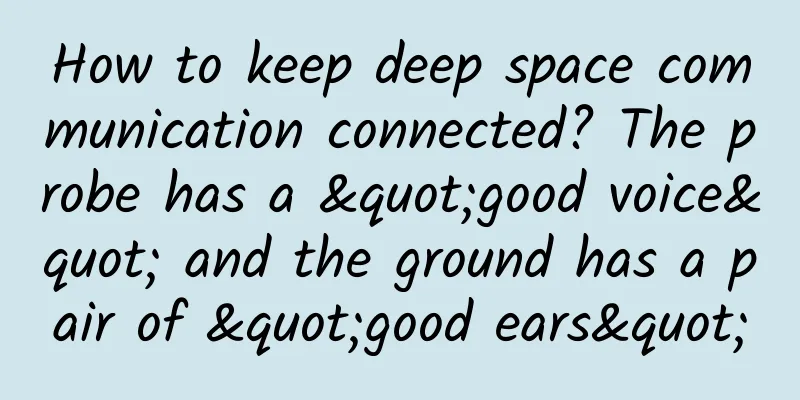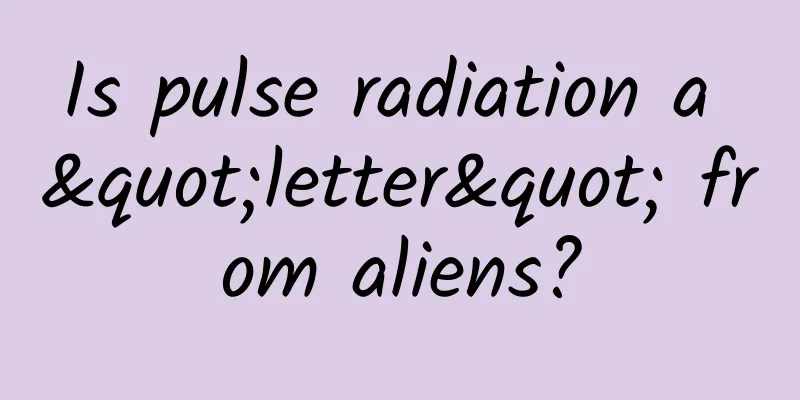How to keep deep space communication connected? The probe has a "good voice" and the ground has a pair of "good ears"

|
There is a lot of high-energy radiation in space, and radio signals can be interfered with. So how do we maintain communication with deep space probes? On September 5, 1977, the space probe Voyager 1 was launched. Since then, it has been in constant communication with the ground control center, always showing the deep space that humans have never set foot in. But in November 2023, humans and Voyager 1 lost contact. To be precise, Voyager 1 is still transmitting signals to the earth, but unfortunately the signals have become meaningless garbled codes. It was not until the end of April this year that the ground team and Voyager 1 reestablished contact with difficulty. As humans explore more distant space step by step, a very important question gradually emerges: How can deep space communications be connected continuously? Rendering of the Voyager 1 probe traveling in deep space How difficult is it to communicate with a deep space probe? In 1965, Gary Flandreau, a doctoral student in aeronautics at the California Institute of Technology who worked part-time at NASA, discovered that Jupiter, Saturn, Uranus, and Neptune would form an arc with the Earth in the late 1970s and early 1980s. It is estimated that this arc will appear every 176 years, and when a spacecraft flies over each planet on this arc, it will be accelerated by the gravity of the planet. If the error range of the flight time can be controlled within tens of minutes, multiple gravitational accelerations can shorten the time it takes for a probe to fly from Earth to Neptune from 30 years to 12 years. Previously, the Mariner 10 probe used gravity to accelerate its flyby of Venus and Mercury, preliminarily verifying the advantages of similar operations. Schematic diagram of spacecraft accelerating with the help of celestial body's gravity In order to seize this once-in-a-century opportunity, NASA launched two "sister" spacecraft, Voyager 2 and Voyager 1, within 15 days in the summer of 1977. They "parted ways" near Saturn, and then Voyager 1 passed through Saturn's rings, passed Titan, and flew out of the solar system's planetary plane; Voyager 2 continued to Uranus and Neptune alone. On August 25, 2012, Voyager 1 passed over the heliosphere and detected the plasma density jump predicted by scientists in the early years. As of 2024, after nearly 47 years of flight, Voyager 1 is about 24 billion kilometers away from the Earth, which is 160 times the distance between the Earth and the Sun. At such a long distance, the ground team needs to wait at least 22.5 hours to receive the radio signal from Voyager 1, and after at least the same amount of time, Voyager 1 can receive the Earth signal through the Deep Space Network. Moreover, considering that Voyager 1 flies a distance of 3 to 4 light seconds (nearly 300,000 kilometers) every day, the waiting time for communication between the Earth and Voyager 1 will continue to increase. Voyager 1 probe operation effect diagram As Voyager 1 moves farther and farther away from Earth, it will become increasingly difficult to maintain effective contact with it. On the one hand, the signal transmission and reception of Voyager 1 mainly rely on radio waves, and the strength of radio signals is inversely proportional to the square of the distance. As the distance increases, the radio signal becomes weaker, and the noise interference generated by the transceiver equipment itself and the cosmic background will become more and more obvious. On the other hand, over the past half century, interference with radio signals from broadcasting, television, mobile phones, etc. on Earth has become increasingly serious, and it will become increasingly difficult for the ground team to receive the information from Voyager 1 in its entirety. So how do we ensure stable deep space communications? This requires the spacecraft and ground teams to work together. Deep space probes need a good voice The first factor is energy supply. In order for the Earth to "hear" clearly, the deep space probe must have a loud voice, that is, the signal strength must be "powerful", so the energy required cannot be underestimated. It can be said that if deep space communication wants to maintain a stable connection, it must first ensure that the probe has sufficient energy supply. Artificial satellites generally rely on solar panels to supplement energy, but Voyager 1 is too far from the sun to use solar energy. To solve this problem, Voyager 1 used atomic energy - radioisotope thermoelectric batteries. This is a device that uses the heat energy generated by the radioactive decay of plutonium-238 to directly supply direct current. Because the amount and speed of energy released by isotope decay are unrelated to the external environment, it ensures that Voyager 1 has sufficient "physical strength" to "call" the earth for a long time. Both Voyager 1 and Voyager 2 use three plutonium isotope batteries as energy. At the beginning of the mission, the initial output of the nuclear battery was about 470 watts. Over time, the power slowly decreased at a rate of about 6.4 watts per year, and the performance of devices such as thermocouples was gradually degraded, and the energy supply effect gradually became poor. Previously, NASA had shut down many subsystems, heaters and scientific instruments of Voyager 1, hoping to extend its working life to 2027, which is the 50th anniversary of the launch of Voyager 1. By then, Voyager 1 will continue to move forward, but it will no longer be able to send data to Earth. The "nuclear battery" equipped by the Voyager series probes The second is a specially made high-gain antenna. The power source of Voyager 1 is not very powerful, so the consumption must be "calculated carefully". For example, the power of the radio signal transmitter it is equipped with is only 22.4 watts, which is even lower than the mobile phone charger we use. The initial wireless signal power is so low that if no measures are taken, the radio waves emitted by Voyager 1 will spread evenly in all directions of space, and the signal "distributed" to the earth will undoubtedly be too little. In order to ensure that the radio signal with low total power is transmitted as far as possible toward the earth, the probe is equipped with a Cassegrain antenna, which is a double-reflector antenna used for microwave communication. It has the advantages of simple structure, flexible design, narrow beam, high gain and low noise, and is widely used in satellite communications. The diameter of the parabolic main antenna of Voyager 1 is 3.66 meters, including the Cassegrain antenna of X-band (about 8.4GHz) and the forward-fed parabolic antenna of S-band (about 2.3GHz). Among them, the main antenna gain of X-band is 47dBi, and it has two transmission modes of 12W and 22W. On the secondary reflector, an S-band low-gain antenna is installed, which is mainly used to transmit circularly polarized waves to the earth. The beam width is 90 degrees, ensuring that Voyager 1 does not need to be precisely aligned in the initial stage of flight, reducing the requirements for attitude control. As for the low-gain antenna, it is mainly used to adjust the attitude in the early stages of the Voyager 1 mission. Close-up of the Voyager 1 probe antenna structure Relying on high-gain antennas, Voyager 1's signals have beam widths of 0.5 degrees in the S-band and 2.3 degrees in the X-band, greatly increasing the signal strength sent to Earth. Among them, the S-band signal is mainly used to send telemetry data, while the X-band signal is used to transmit high-resolution images and scientific data. Then there is precise attitude control. In order to increase the antenna gain for signal transmission, Voyager 1 controls the radio beam to be very narrow. In order to aim the high-gain antenna at the earth, the probe's attitude must be precisely controlled. Otherwise, it is easy to "make a mistake by a hair's breadth and lead to a huge error", resulting in the probe being disconnected from the ground station. On July 21, 2023, an error occurred when NASA sent a command to Voyager 2, causing its antenna to deviate 2 degrees from the direction of the Earth, and the ground team and the probe were instantly disconnected. It was not until August 4 that the probe finally resumed communication with the ground team after calibrating the antenna according to the new command. Finally, there is the communication signal itself. Voyager 1 uses 8.4GHz and 2.3GHz communication frequencies, which belong to the X-band and S-band of deep space communication uplink and downlink frequency allocation. These two bands were chosen because there is almost no interference in the relevant frequency bands, and the artificially generated radio noise is small, thus improving the signal-to-noise ratio and facilitating the maintenance of ground-to-space radio communications. However, Voyager 1 is too far away from the Earth, and there are many complex and unknown high-energy radiation in space, so radio signals are still interfered with. According to Shannon's formula, the reliable rate that can actually be achieved in communication depends on the ratio of the signal to the background noise. This means that the longer the transmission distance, the lower the achievable transmission rate. The signals of the Voyager probes are interfered by complex factors in deep space. In 1994, when Voyager 1 was about 6 billion kilometers from Earth, the communication rate was 7.2 kilobits per second. In 2007, when Voyager 1 was about 12.6 billion kilometers from Earth, the communication rate dropped to 1.4 kilobits per second. By the beginning of this year, the communication rate between Voyager 1 and Earth could only reach 160 bits per second, which is slower than the speed of dial-up Internet access in the 1990s. In order to reduce the pressure of data transmission and transmit more data back to Earth with the same transmission capacity, data compression technology is used in the field of deep space exploration. In order to preserve the original images and scientific data as much as possible, deep space communication generally uses lossless compression, with a low compression ratio of about 3:1. The uncompressed "Voyager 1" image is 800×800 pixels, with 8 bits of grayscale per pixel. In fact, typical planetary or satellite images contain a lot of black, which is invalid information. By calculating the difference between the grayscale levels of adjacent pixels, image data compression can reduce the amount of data in a typical planetary image by 60%. Due to weak signals, interference and other reasons, the data received by the earth station is likely to be erroneous. If the data is retransmitted every time an error is found, it will inevitably be time-consuming and labor-intensive when the communication delay is getting longer and longer. Therefore, deep space probes use error correction coding technology, which can detect erroneous data by mathematically checking the received signals. "Voyager 1" initially used a single-channel telemetry system of cascaded Gray code + convolutional coding, and later upgraded it to cascaded Reed-Solomon code + convolutional coding in orbit, that is, a typical cascade code scheme with convolutional code as the inner code and Reed-Solomon code as the outer code. The so-called error correction coding actually reduces the information bit error rate by increasing the bit rate of relevant information and strengthening signal redundancy. Using the Gray coding algorithm to send 1 bit of information requires 1 bit of overhead, while the Reed-Solomon coding scheme reduces the overhead to 1 bit for every 5 bits of information sent, and the information bit error rate is reduced from 5/1000 to 1/100000. With the improvement of computing processing power, new deep space probes are also gradually adopting long codes such as Toubo code and LDPC code with better performance for channel coding. The ground needs "good ears" In order to achieve reliable deep space communication, we cannot rely solely on the probe. The ground station also needs to work together to open up the ground-to-space communication link. On the one hand, it is necessary to build a deep space tracking and control network covering the entire world. Since the rotation of the earth will block signals and greatly affect communication effects, only by deploying a certain number of deep space communication facilities around the world can we ensure that the ground team and the deep space probe are continuously connected. The communication between Voyager 1 and the Earth is achieved through NASA's Deep Space Exploration Network. This is a network composed of three integrated tracking and control communication facilities distributed around the world. It is also the world's most powerful and largest deep space tracking and control communication system. Each set of facilities includes a main antenna with a diameter of 70 meters, 4 to 7 secondary antennas with a diameter of 34 meters, and a small and medium-caliber antenna with a diameter of 26 meters and a diameter of 11 meters, which can communicate with the spacecraft uninterruptedly. NASA's Deep Space Network system was built in 1958. After three years, three deep space station systems were built in Goldstone, California, Woomera, Australia, and Johannesburg, South Africa. In 1963, it was officially named the Deep Space Network. In 1965, NASA built two new deep space stations in Madrid, Spain and Canberra, Australia. In 1974, NASA closed the Woomera and Johannesburg facilities, forming the current three-station structure. These stations are controlled, maintained and managed by NASA's Jet Propulsion Laboratory in Pasadena, California. Goldstone radar station in the California desert In addition to the United States, other countries and organizations are also actively building deep space networks. For example, the European Space Agency has built a deep space network including the New Norshe Station in Australia, the Ceferros Station in Spain, and the Malaguey Station in Argentina, which is remotely operated and controlled by the European Space Operations Center in Darmstadt, Germany. my country has deployed deep space stations in Jiamusi (the easternmost part of the country), Kashgar (the westernmost part of the country), and Zapala (western Argentina), achieving effective communication with more than 92% of the sky coverage. Russia, Japan, India and other countries have also developed and built deep space tracking and control equipment, but have not yet formed a complete deep space tracking and control network. Some of the ground facilities and special ships used by Russia were inherited from the Soviet Union. Foreign deep space communication ground stations On the other hand, powerful ground equipment is needed. Ground facilities specifically used for deep space spacecraft tracking and control and data transmission are generally equipped with large-aperture parabolic antennas, high-power transmitters, extremely high-sensitivity receiving systems, signal processing systems, and high-precision and high-stability time and frequency systems. They can track and control deep space spacecraft at least millions of kilometers away from the earth. Large-aperture antennas for the Deep Space Exploration Network Among the ground equipment for deep space communications, the most eye-catching is the huge antenna. The fully movable parabolic high-gain reflective antenna with a diameter of 70 meters is used to communicate with Voyager 1. This antenna was upgraded from a 64-meter diameter antenna after the implementation of the Voyager program. By removing the old metal panels and structural brackets of the original antenna, installing a new external support structure and precision panels, and adjusting the panel surface to sub-millimeter accuracy. In addition, the antenna also introduces holographic alignment technology to accurately focus X-band radio frequency signals. According to statistics, the area of the 70-meter aperture antenna reaches 3,850 square meters, equivalent to 10 basketball courts, with a total weight of more than 2,500 tons, and a gain of more than 20 million times. After being focused and amplified by a 70-meter-diameter antenna, the signal strength of Voyager 1 is only one hundred thousandth of the weakest signal that a normal mobile phone can receive. In order to receive such a weak signal, the receiving component of the antenna needs to be cooled to near absolute zero, and the superconducting effect is used to achieve ultra-high sensitivity and extremely low noise. The device then amplifies the received signal to restore the original signal. In addition to "making every effort" to receive signals, "making every effort" to send signals to deep space probes is also required. Take the 70-meter diameter antenna at NASA's Canberra Communications Station in Australia as an example. In order to "take care of" the signal receiving device of "Voyager 1", the ground station "invested a lot" and the S-band transmission output power reached 400 kilowatts. Despite this, the command rate sent to "Voyager 1" at a frequency of 2.1GHz can only reach 16 bits/second, which shows how difficult deep space communication is. |
<<: Why do middle-aged men love fishing so much?
Recommend
A car is equivalent to a large mobile phone on four wheels. Did everyone understand this Hongmeng Intelligent Driving Technology Conference?
Every sentence he said was about being far ahead....
Tik Tok short video promotion plan and channels!
Why is the content of my short video very good, b...
To save half of the money for Buick GL6 owners, Baojun 360's starting price may be less than 60,000
In the MPV segment, Buick has its own MPV, Buick ...
Visual immersion is not enough, VR still needs multi-dimensional sensory stimulation
Recently, the concept of "virtual reality&quo...
What happened when Beijing issued the blue high temperature warning signal? What is the high temperature in Beijing?
Beijing issues blue warning for high temperature ...
Dr. Mo reviews iPhone 6S: The best smartphone ever
Apple has just released its new smartphone, iPhon...
Android high imitation taxi and other software project source code
Source code introduction This project is modeled ...
How to improve the opening rate of APP activity push?
Activity push is an important way for products to...
What should I do if my family or colleague is infected with the new coronavirus?
In recent days Multiple sporadic cases have occur...
Short video live streaming is not very effective in selling products. Is it useful to insist on publishing works?
The total number of active users on Kuaishou and ...
The top ten "down-to-earth" advertisements of 2019, I am convinced!
I heard that advertisers have received another di...
Data analysis of information flow audience portrait. If you can understand it, I lose!
I have been doing advertising optimization for a ...
7 simple ways to quickly understand user dads through online data
No matter what kind of marketing we do, we need t...
Great Wall WEY VV7 real shot at Guangzhou Auto Show: Can front-wheel drive SUV challenge Toyota Land Cruiser?
More and more domestic automobile brands have reg...
Why does it hurt when you see others getting hurt?
Have you ever had such an experience? In life, wh...









